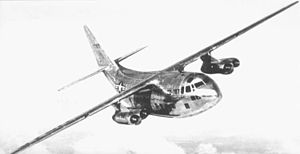Chase XC-123A
| XC-123A | |
|---|---|

| |
| Role | Military transport aircraft |
| Manufacturer | Chase Aircraft |
| Designer | Michael Stroukoff |
| First flight | 21 April 1951 |
| Primary user | United States Air Force |
| Number built | 1 |
| Developed from | Chase XCG-20 |
| Career | |
| Other name(s) | Jet Avitruc |
| Serial | 47-787 |
| Fate | Converted to YC-123D 53-8068 |
The Chase XC-123A was an experimental transport aircraft developed by Chase Aircraft. The first jet-powered transport built for the United States Air Force, it was intended for use as a high-speed transport for high-priority cargo and personnel. The XC-123A was determined to have insufficient advantages over existing types in service, and did not go into production. The sole prototype was converted into the piston-powered Stroukoff YC-123D to evaluate boundary layer control systems.
Design and development
In the late 1940s, Chase Aircraft had developed the XG-20, the largest glider ever built in the United States.[1] By the time it was ready for operations, however, U.S. military doctrine had been altered to remove the requirement for the use of transport gliders in combat.[2]
However, the XG-20's aircraft had been designed to allow for the easy installation of power plants, and Chase modified the two prototypes into powered aircraft, one becoming the
Operational history
Dubbed "Avitruc" by its manufacturer,[5] the XC-123A conducted its maiden flight on April 21, 1951,[4] becoming the first jet-powered transport aircraft to successfully fly in the United States.[4] It was considered "excellent" in flight trials, with the aircraft showing few vices,[6] and demonstrating reasonably good short-field capability.[4]
Despite this, even as the XC-123 proved successful, the XC-123A failed to win sufficient favor in flight testing to receive a production order. Although the aircraft's short-field performance was good, on rough, unimproved fields the low-slung jet pods would suck debris into the intakes, damaging the engines.[4] In addition, the aircraft's design was mismatched to its engines,[7] resulting in the XC-123A being incapable of providing sufficient cargo capacity compared to the amount of fuel its jet engines required.[2] As a result, the XC-123A project was abandoned without additional aircraft being built.[2]
Following the conclusion of trials, the XC-123A was converted to be powered by two
Specifications (XC-123A)

Data from Gunston[6] and Adcock[4]
General characteristics
- Crew: 3
- Length: 77 ft 1 in (23.50 m)
- Wingspan: 110 ft 0 in (33.53 m)
- Height: 33 ft 10 in (10.31 m)
- Wing area: 1,222.78 sq ft (113.600 m2)
- Airfoil: NACA 23017[10]
- Empty weight: 25,000 lb (11,340 kg)
- Max takeoff weight: 60,000 lb (27,216 kg)
- Powerplant: 4 × General Electric J47-GE-11 turbojets, 5,200 lbf (23 kN) thrust each
Performance
- Maximum speed: 500 mph (800 km/h, 430 kn)
- Cruise speed: 400 mph (640 km/h, 350 kn)
See also
Related development
Aircraft of comparable role, configuration, and era
- Avro Ashton
- Avro Canada C102 Jetliner
- Vickers Type 618 Nene-Viking
Related lists
- List of military aircraft of the United States
References
Notes
Bibliography
- Adcock, Al (1992). C-123 Provider in action. Aircraft In Action. Vol. 124. Carrollton, TX: Squadron/Signal Publications. ISBN 978-0-89747-276-0.
- Air League (1975). "Chase XC-123A". Air Pictorial. 37. London: Air League of the British Empire: 113.
- Baugher, Joe (2010). "1946-1948 USAAF Serial Numbers". USAAS-USAAC-USAAF-USAF Aircraft Serial Numbers--1908 to Present. Retrieved 2010-11-28.
- Baugher, Joe (2010). "1953 USAAF Serial Numbers". USAAS-USAAC-USAAF-USAF Aircraft Serial Numbers--1908 to Present. Retrieved 2011-01-22.
- ISBN 978-0-89673-077-9.
- Lednicer, David (2010). "The Incomplete Guide to Airfoil Usage". University of Illinois at Urbana-Champaign. Archived from the original on 2010-04-20. Retrieved 2010-11-27.
- Mitchell, Kent A. (1992). "The C-123 Provider". AAHS Journal. 37. Santa Ana, CA: American Aviation Historical Society. Retrieved 2010-11-28.
- ISBN 978-0-600-37248-6.
External links
- Bonnier Corporation (July 1951). "Jet Power Troop Transport". Popular Science. Bonnier Corporation. p. 81.
